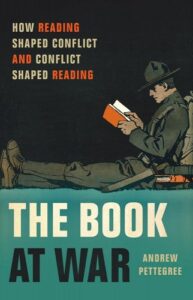The Penguin contract with the army for the Forces Book Club was a coup Allen Lane plotted with long-time crony Bill Williams, now comfortably installed at the Army Bureau of Current Affairs: it brought with it a precious allocation of paper from the government reserve. The news of this exclusive contract brought predictable indignation from other publishers, who attempted to challenge the Penguin monopoly with a service library scheme of their own. Williams thought Lane should not be overly concerned. ‘If I know anything of the PA [Publishers Association] I think we may well be in for a protracted correspondence and at the end of it get nowhere.’ That, as far as histories of the triumphant march of Penguin books would have it, is pretty much the end of the story. But in fact, the publishers’ consortium did launch their own paperback strand, Guild Books, with titles competitively priced at 6d, 9d and 1s. The participants in the new Publisher’s Guild, which included Cape, Cassell, Murray, Faber and Heinemann, had considerable firepower; possessing as they did the copyright of a large proportion of contemporary fiction, they could supply the sort of materials craved by soldiers. In due course they issued their own Services Edition as a purely commercial venture.
Paperbacks made up an ever-increasing proportion of troops’ libraries, indispensable in the camps of North Africa, on board troopships or in the small collections troops carried with them in their kitbags. When, from time to time, librarians serving in the forces wrote to the Library Association with their experiences of libraries in the field, paperbacks were a ubiquitous presence. One, charged with setting up a troopship library for 1,7oo men, put out an appeal for donations from those on board that brought in forty Penguins to augment titles from the Everyman’s Library and Nelson Classics. P. Hepworth, formerly of Sheffield Public Library, was stationed at a major service facility in the North African desert. This had three libraries, including an Information Room stocked with twenty copies of the Egyptian Mail (an English-language daily paper), miniature airmail issues of the Manchester Guardian and The Times and the ever-popular Soviet War News. Readers could also find Pelicans such as Sharp’s Town Planning, Ifor Evans’s English Literature and a Penguin Herodotus; these tended to vanish and would, in Hepworth’s view, have been better off in the station’s main lending library. The reading room next door had more Penguins of a purely recreational nature.
With so much creative energy in the industry, soldiers were spoilt for choice. In 1945 Hutchinson gave away a million paperbacks as a free victory gift for the forces, which suggests they must have had a large stock on hand. My own copy of the Guild Books Services edition of Robert Gibbings’s Sweet Thames Run Softly (1944) was repurposed after the war when the government sold off surplus stock. The stern injunction on the back cover, ‘this book must not be resold’, was now superseded by a label on the front indicating that the stock had been transferred to W. H. Smith and would be sold for one shilling.
By far the most famous and successful venture in providing books for the troops was the Armed Services Editions (ASE) published in the United States: this built effectively on the ongoing paperback revolution. When the Victory Books Campaign was suspended in 1943, the future of book provision for the troops lay in the hands of the Council on Books in Wartime, an industry body established in March 1942. It took some time to find its direction; initially it was, in the words of one observer, ‘a committee in search of a project’. Gradually opinion converged around the idea of a series of specially printed paperbacks, to be distributed free to troops in the field. Publishers would nominate possible titles, which would then be examined by members of the council. When they had made their choices, these would then be submitted to the army and navy, in the persons of Raymond Trautman and DuBois, for approval. The emphasis was on variety: a good portion of the list would be contemporary fiction, but with plenty of historical novels, mysteries, books of humour and Westerns: the evergreen Zane Grey led the way, with nine titles in the series. But there was also a rich layer of modern literary fiction, Hemingway, Dorothy Parker, Sinclair Lewis and John Steinbeck, who featured with eight titles. There was a smattering of poetry, from Longfellow and Shelley to Rupert Brooke and Robert Frost. The classics were well represented: Dickens with his three most accessible titles, Oliver Twist, David Copperfield and The Pickwick Papers, Thackeray, Conrad (five titles) and Voltaire’s Candide. The grunt who drew Thoreau, Sterne or Tolstoy might well have gone looking for an exchange with Bram Stoker’s Dracula or any one of the six books by Mark Twain reproduced in the series.
A strong feature of the list was the presence of English authors, Somerset Maugham (six titles), J. B. Priestley, A. J. Cronin, a bestseller on both sides of the Atlantic, and Richard Llewellyn’s How Green Was My Valley. The all-time favourite, with no fewer than twelve titles, was C. S. Forester of Hornblower fame. Non-fiction was added to the series much more sparingly, with books about war, and especially the current war, making up only a tiny fraction of the 1,322 titles in the series. The non-fiction titles included Embree’s Japanese Nation, issued during the occupation, and Dietz, Atomic Energy in the Coming Era. The war books included a selection from Homer’s Odyssey and highlights from Yank, the soldier’s magazine.
A special effort was made to push science, with Science Goes to War, The Science Yearbook of 1944 and 1945, and Men of Science in America. More consequential was the decision to include titles by Edgar Snow, the journalist responsible for the book that introduced Mao Zedong to the West, and Howard Fast, the post-war bête noire of the Committee of Un-American Activities. Soldiers seem especially to have enjoyed The Postman Always Rings Twice, a salacious and violent crime novel banned in Boston, but printed twice in the ASE series. Forever Amber, a semi-pornographic historical romp banned in fourteen US states and Australia, also seems to have found favour. It topped the US bestselling list in 1945 and went on to sell 3 million copies. Another striking choice for a segregated army was Shirley Graham’s There Was Once a Slave, the story of Frederick Douglass.
Most innovative of all was the format, a paperback approximately 16 by 11 centimetres, bound along the short side. The text was set in two columns for ease of reading. Initially 5o,ooo copies would be published of thirty titles per month. The first 1.5 million copies were distributed in September 1943, and print runs rose steadily as their reputation spread among the troops. By the time the scheme was discontinued in September 1947, the council had distributed some 122 million copies of 1,322 titles to millions of serving men all around the globe. This was in itself a tribute to the US forces’ mastery of military logistics. Bundles of books were flown into the Anzio bridgehead in Italy; others were delivered by parachute to garrisons on small Pacific islands. Charles Rawlings, a war correspondent for the Saturday Evening Post, witnessed a distribution on a Pacific station – an orderly queue filing past to take one book at a time: ‘No time to shop and look for titles. Grab a book, Joe, and keep goin’, you can swap around afterwards.’ As for the soldier who grabbed A Tree Grows in Brooklyn, ‘the guy that got that one howled with joy’. Rawlings was pleased to be included in the allocation when he travelled with the GIs on a troopship to Australia: ‘We read out twenty-five blessed days on them.’
___________________________________





















